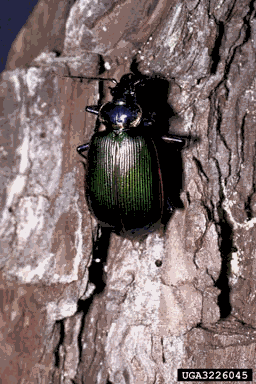

|
| This beetle (Calosoma sycophanta) can eat as many as 150 gypsy moth caterpillars in its lifetime. Image from the Bugwood Network and USDA (http://www.forestryimages.org/). |
The gypsy moth (Lymantria dispar) is a species accidentally introduced to New England in the 1800's. It has no natural enemies here, so the bugs face no environmental resistance in our area. In some years, the population grows to huge numbers, causing great damage to the trees the caterpillars feed on.
The blue line on the graph represents the unchecked growth. Anything over 1 million adults is considered to be too many. As you can see, the population quickly grows above one million. Is there anything we can do to reduce these numbers?
One approach is to apply a chemical pesticide. A chemical pesticide is a density-independent mortality factor. It has the effect of killing a large number of individuals in a single generation. But in many cases, future generations are free to grow again. (An exception would be if we used a persistent pesticide--typically a dangerous and illegal practice.)
The yellow line represents the case where a pesticide is applied in generation two. You can see a temporary dip in population with a quick resumption of exponential growth. Two generations later the population is again over a million.
Instead of applying a chemical pesticide, we could use a biological control, a predator or parasite of the gypsy moth. An introduced predator is a density dependent factor since the number of gypsy moths would determine the level of predators. The predator would exert a continuing effect over many generations. The effect of a predator is to decrease the level of recruitment (ie, reduce the number of caterpillars that survive to reproduce).
The pink line simulates the gypsy moth population when a predator is introduced in generation two. Notice that even though there is no dramatic drop, the population stabilizes at a level below a million. The predator continues to exert an effect long after it is released.
Disclaimer: The pictured beetle does eat gypsy moths, and there are a virus (nucleopolyhedrosis virus--NPV) and a fungus (Entomophaga maimaiga) that act as biological controls of the gypsy moth. But this example is for demonstration purposes only. The numbers and growth model should not be interpreted as real gypsy moth population data. You can get details of the calculations for this population model from gmcalcs.htm.

Gypsy moth links:
http://www.fs.fed.us/ne/morgantown/4557/gmoth/home.html General gypsy moth info from the US Forest Service
http://www.ent.msu.edu/gypsyed/ Info on predators plus more links from Michigan State University
http://www.forestpests.org/MHDEUSA/HDUSAGM.html General info from the Bugwood Network
Anthony G Benoit
abenoit@trcc.commnet.edu
(860) 885-2386
Revised